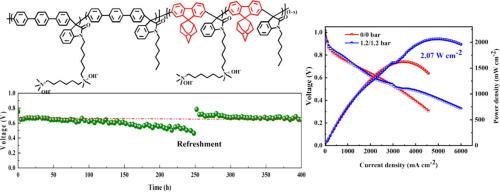松散疏水微相促进燃料电池阴离子交换膜中离子通道的形成
IF 13.2
1区 工程技术
Q1 ENGINEERING, CHEMICAL
引用次数: 0
摘要
构建明确的离子通道有助于提高燃料电池阴离子交换膜的导电性和稳定性。本文通过在聚芳基吲哚骨架上加入螺旋-金刚烷-芴(SAF)单元,并接枝阳离子侧链,设计了高性能的AEMs。分子动力学模拟和电导率测量显示,SAF单元具有高度的体积和刚性,可以降低骨架堆积密度和疏水微相的适当疏松,从而降低微相分离过程中阳离子聚集的阻力,并促进离子簇连接(当水合时),从而创建更快OH−扩散的连续途径。优化后的AEM具有161.9 mS cm−1的高氢氧化物电导率(80 °C,中等IEC为2.32mmol/g);其H2/O2燃料电池在80 °C时的峰值功率密度为2.07 W cm−2,耐久性为250 h;AEM在分阶段、长时间(>;400 h)燃料电池在60 °C和200 mA cm−2催化层刷新后运行。本研究揭示了疏水微相松散对离子通道形成的重要作用,为AEM设计提供了更好的电导率和稳定性平衡的新指导;这对碱膜燃料电池的进一步发展具有潜在的推动作用。本文章由计算机程序翻译,如有差异,请以英文原文为准。

Loosened hydrophobic microphase to facilitate ion channel formation in anion exchange membrane for fuel cell applications
Constructing well-defined ion channels can contribute to high conductivity and stability of anion exchange membranes (AEMs) for fuel cells. Herein, high performance AEMs are designed by incorporating spiro-adamantane-fluorene (SAF) unit into poly (aryl indole) backbone, which is then grafted with di-cation side chains. Featuring integrated high degree of bulkiness and rigidity, the SAF unit gives rise to decreased backbone packing density and suitably loosened hydrophobic microphase, thus lowers the resistance of cation aggregation during microphase separation, and facilitates ion cluster connection (when hydrated) to create continuous pathways for faster OH− diffusion as revealed by molecular dynamic simulation and conductivity measurements. The optimized AEM displays a high hydroxide conductivity of 161.9 mS cm−1 (at 80 °C, and medium IEC of 2.32mmol/g); its H2/O2 fuel cell yields an outstanding peak power density of 2.07 W cm−2 at 80 °C and a durability of 250 h; the AEM remains stable after staged, prolonged (> 400 h) fuel cell operation at 60 °C and 200 mA cm−2 after the refreshment of catalytic layers. This work reveals the important role of loosened hydrophobic microphase for ion channel formation, and provides a new guide for AEM design toward better balanced conductivity and stability; it may potentially contribute to further advancement of alkali membrane fuel cells.
求助全文
通过发布文献求助,成功后即可免费获取论文全文。
去求助
来源期刊

Chemical Engineering Journal
工程技术-工程:化工
CiteScore
21.70
自引率
9.30%
发文量
6781
审稿时长
2.4 months
期刊介绍:
The Chemical Engineering Journal is an international research journal that invites contributions of original and novel fundamental research. It aims to provide an international platform for presenting original fundamental research, interpretative reviews, and discussions on new developments in chemical engineering. The journal welcomes papers that describe novel theory and its practical application, as well as those that demonstrate the transfer of techniques from other disciplines. It also welcomes reports on carefully conducted experimental work that is soundly interpreted. The main focus of the journal is on original and rigorous research results that have broad significance. The Catalysis section within the Chemical Engineering Journal focuses specifically on Experimental and Theoretical studies in the fields of heterogeneous catalysis, molecular catalysis, and biocatalysis. These studies have industrial impact on various sectors such as chemicals, energy, materials, foods, healthcare, and environmental protection.
 求助内容:
求助内容: 应助结果提醒方式:
应助结果提醒方式:


